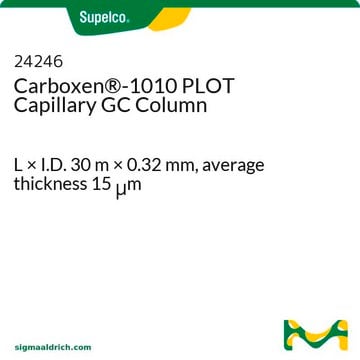25461
Carboxen®-1006 PLOT Capillary GC Column
L × I.D. 30 m × 0.53 mm, average thickness 30 μm
Sign Into View Organizational & Contract Pricing
All Photos(1)
About This Item
UNSPSC Code:
41115710
Recommended Products
material
fused silica
description
PLOT = Porous Layer Open Tubular
manufacturer/tradename
Carboxen®
parameter
≤25-250 °C temperature (isothermal or programmed)
average thickness
30 μm
df
30 μm
technique(s)
gas chromatography (GC): suitable
L × I.D.
30 m × 0.53 mm
matrix active group
Carbon molecular sieve phase
application(s)
chemicals and industrial polymers
food and beverages
column type
capillary PLOT
Looking for similar products? Visit Product Comparison Guide
General description
Carboxen® Adsorbent is ideally used for solid-phase microextraction (SPME) and does efficient extraction of small polar molecules from aqueous solution. Porous-layer open-tubular (PLOT) columns are a powerful tool used for analyzing fixed gases, light hydrocarbons and volatile solvents in gas chromatography method. They are mostly preferred over traditional packed columns.
Application: This column is ideal for the separation of many permanent gas components (such as helium, hydrogen, nitrogen, carbon monoxide, methane, and carbon dioxide), and light hydrocarbons (C2-C3) in the same analysis. It is ideal for resolving formaldehyde/water/methanol (formalin) mixtures and monitoring impurities in ethylene. This column can be used with high flow rates and rapid temperature programs to ensure excellent, fast separations.
USP Code: None
Phase:
USP Code: None
Phase:
- Carbon molecular sieve
- Subambient to 250 °C (isothermal or programmed)
Other Notes
We offer a variety of chromatography accessories including analytical syringes
Legal Information
Carboxen is a registered trademark of Merck KGaA, Darmstadt, Germany
Storage Class Code
11 - Combustible Solids
WGK
WGK 3
Flash Point(F)
Not applicable
Flash Point(C)
Not applicable
Choose from one of the most recent versions:
Already Own This Product?
Find documentation for the products that you have recently purchased in the Document Library.
Customers Also Viewed
Applications of Solid Phase Microextraction
Pawliszyn J.
Applications of Solid Phase Microextraction, 64-65 (1999)
Porous layer open-tubular capillary columns: preparations, applications and future directions.
Zhenghua Ji
Journal of Chromatography A, 842 (1), 115-142 (1999)
B D Page et al.
Journal of chromatography. A, 873(1), 79-94 (2000-04-11)
The headspace solid-phase microextraction (HS-SPME) efficiencies from vegetable oil of the recently available Carboxen-poly(dimethylsiloxane) (PDMS) and divinylbenzene-Carboxen-PDMS fibres were found to be much greater than those of the PDMS fibre for a number of volatile contaminants. Using these Carboxen-based fibres
Dawn M Chapman et al.
Journal of agricultural and food chemistry, 52(17), 5431-5435 (2004-08-19)
A rapid and automated solid phase microextraction (SPME) stable isotope dilution gas chromatography/mass spectrometry (GC-MS) method for 2-methoxy-3-isobutylpyrazine (MIBP) quantification in red wine was developed. Wines with 30% (w/v) NaCl and 2-methoxy-(2)H(3)-3-isobutylpyrazine internal standard were sampled with a 2 cm
Lucia Giordano et al.
Journal of chromatography. A, 1017(1-2), 141-149 (2003-10-31)
A new method was developed for the determination of 2-furfural (2-F) and 5-methylfurfural (5-MF), two products of Maillard reaction in vinegar, with head-space solid-phase microextraction (HS-SPME) coupled to gas chromatography-mass spectrometry (GC-MS). A divinylbenzene (DVB)/carboxen (CAR)/polydimethylsiloxane (PDMS) fibre was used
Chromatograms
suitable for GCOur team of scientists has experience in all areas of research including Life Science, Material Science, Chemical Synthesis, Chromatography, Analytical and many others.
Contact Technical Service



